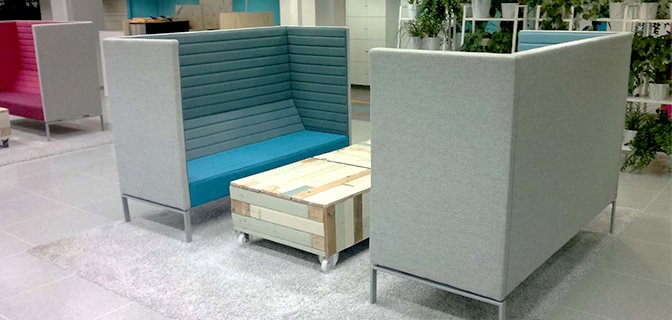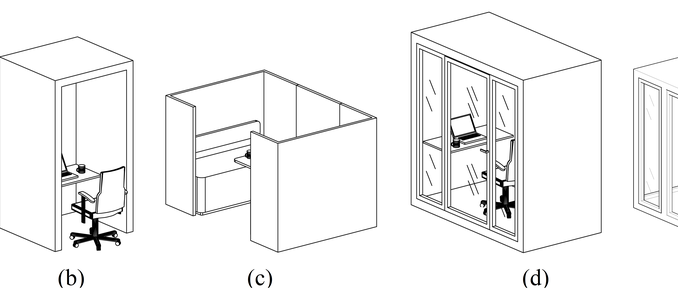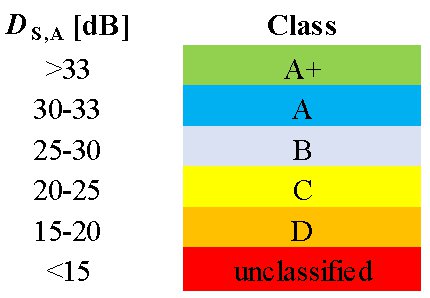
Acoustic testing of soundproof furniture ensembles and booths (ISO 23351)
Summary
Acoustics Group at Turku University of Applied Sciences (Turku UAS) has been actively involved with the development of two international standards, which are used to test the acoustic properties of furniture ensembles and booths. This page summarizes the essential drivers of this work, essential outcomes, and the current situation of this development.
Why all this?
Noise caused by other colleagues’ speech and lack of speech privacy are very usual problems in open work and study spaces. Room acoustic solutions (absorbers, screens, sound masking, textile flooring) should be applied to avoid excessive problems. Problems can be also mitigated by sound attenuating furniture ensembles, such as
- Mobile phone booths,
- Mobile work and meeting rooms, and
- Sound attenuating workstations.
Examples of them are shown in Fig. 1.

The market of such products was seen to increase in 2010. Therefore, the Acoustics Group at Turku UAS started to develop a method to measure their acoustic properties in laboratory environment. The method was published in a scientific journal in 2016 (Hongisto et al. 2016). The outcome is the speech level reduction, DS,A [dB]. It describes how much the A-weighted sound power level of speech radiated outside is reduced by the product.
Laboratory test standard ISO 23351-1
Until June 2020, there was no standardized method to measure or declare the attenuation properties of abovementioned products. Turku University of Applied Sciences proposed via Metsta/SFS to DIN in 2017 that the method of Hongisto et al. (2016) could be standardized. This proposal was internationally accepted in 2018.
The standardization work started in 2018 and ended in 2020. The outcome was ISO 23351-1 standard.
The uncertainty of the standard is based on international Round Robin test reported by Hongisto et al. (2020).
The standard involves a classification method shown in Fig. 2. It is largely based on a survey of commercial phone booths published by Hongisto and Keränen (2020).

Field test method ISO CD 23351-2
Field test standard does not exist yet, but it is under development.
Need for field test standard raised independently from four parties: acoustic test laboratories, acoustic consultants, manufacturers, and buyers. All of them had different reasons:
- ISO 23351-1 laboratory test cannot be conducted for booths larger than 10 15 m3 in volume.
- Acoustic consultants need to verify the properties in the any location to determine their properties in workplace design, product development, and purchasing projects.
- Buyers want to verify, whether the acoustic properties of a purchased product fulfils the specifications given by the seller.
- Manufacturers should be able to test their prototypes in their own spaces, since several tests are made every day. Laboratory testing in another city are not possible nor needed.
Turku University of Applied Sciences begun to develop the method in 2021 by analyzing different approaches of testing. This work is documented by Keränen et al. (2023). Based on this work, Turku University of Applied Sciences proposed via Metsta/SFS to DIN in 2022 that field test method should be standardized. The standardization work started in June 2023, and it is still ongoing. The official page showing the existence of this working group.
At moment, the first committee draft (ISO CD 23351-2-2024) is under international consultation which ends in May 2024. Based on these comments, the first draft standard (DIS) is submitted to international ballot in October 2024. The final draft standard is submitted to international ballot in spring 2025. If these two ballots are accepted, the standard could be available in autumn 2025.
Recently, Turku University of Applied Sciences has investigated the uncertainty of ISO CD 23351-2 method. The results will be published in Internoise 2024 and utilized in ISO DIS 23351-2.
Our test services to furniture manufacturers
Turku University of Applied Sciences has provided test services according to ISO 23351-1 already 7 years. Test service was FINAS accredited in 2022.
Research at Turku UAS
Turku University of Applied Sciences is currently working on three independent studies touching this topic.
- Laboratory experiment investigating the effect speech on cognitive performance and stress. Three levels are investigated: speech without booth, speech through class C booth, speech from class A booth.
- Field experiment investigating how the addition of booths affects office employees’ environmental satisfaction.
- Laboratory study about the measurement uncertainty of ISO CD 23351-2.
Bibliography
Hongisto, V., Keränen, J., Virjonen, P., Hakala, J. (2016). New method for determining sound reduction of furniture ensembles in laboratory, Acta Acustica united with Acustica 102 67–79.
Hongisto, V., Keränen, J., Hakala, J. (2020). Accuracy experiment of ISO DIS 23351-1 – speech level reduction of furniture ensembles and enclosures. Applied Acoustics 164 107249.
Hongisto, V., Keränen, J. (2020). Acoustic performance of eleven commercial phone booths according to ISO 23351-1. Research Reports from Turku University of Applied Sciences 51, 20 pp., Turku University of Applied Sciences, Turku, Finland. At:
http://julkaisut.turkuamk.fi/isbn9789522167743.pdf.
Keränen, J., Hakala, J., Laukka, J., Hongisto, V. (2023). Alternative measurement methods for speech level reduction of booths in field conditions. Forum Acusticum 2023, 11 15 Sep, Turin, Italy. Open access:
https://appfa2023.silsystem.solutions/atti/000392.pdf.
